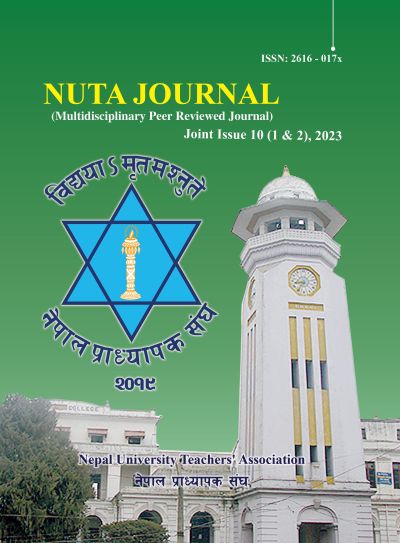कर्णाली प्रदेशमा सहरीकरणको वर्तमान अवस्था {Present Situation of Urbanization in Karnali Province}
DOI:
https://doi.org/10.3126/nutaj.v10i1-2.63075Keywords:
सहरीकरण, नगरपालिका, जनसंख्या, जनघनत्व, सडक सञ्जाल, urbanization, municipality, population, population density, road networkAbstract
यो अध्ययन कर्णाली प्रदेशमा सहरीकरणको वर्तमान अवस्थामा केन्द्रित छ । यस अध्ययनमा कर्णाली प्रदेशका नगरपालिकाहरूको स्थापना र विकासक्रमको विवरण, जिल्लागत नगर जनसङ्ख्या, नगरपालिकाहरूको जनसङ्ख्या, नगर जनघनत्व, नगरपालिकाहरूको वार्षिक जनसङ्ख्या वृद्धिदर र कर्णाली प्रदेशमा सडक सञ्जाल, सहरी विकास सम्भावनाका बारेमा द्वितीय स्रोतबाट प्राप्त सूचना र तथ्याङ्कहरूलाई भौगोलिक सूचनाप्रणालीको उपयोग गरी वर्णनात्मक विधिबाट विश्लेषण र व्याख्या गर्ने प्रयास गरिएको छ । । नेपालले मुख्य रूपमा जनसङ्ख्यालाई मुख्य आधार मानेर समयक्रममा सहरी क्षेत्र तोक्ने आधारहरू परिवर्तन गर्दै आएको छ । हाल नेपालमा ६वटा महानगरपालिका ११ वटा उपमहानगरपालिका र २७६ वटा नगरपालिकाहरू गरी कुल २९३ नगर क्षेत्रहरूको स्थापना भएको छ । यीमध्ये कर्णाली प्रदेशमा कुल ७९ स्थानीय तह रहेका छन्, जसमा २५ वटा नगरपालिका रहेका छन् । अध्ययनको निष्कर्षअनुसार नगर सङ्ख्याको हिसाबले हेर्दा कर्णाली प्रदेशमा रहेका कुल १० जिल्लामध्ये सबैभन्दा धेरै ५ नगरपालिकाहरू सुर्खेत जिल्लामा देखिन्छन् भने हुम्ला जिल्ला नगरपालिका विहीन छ । नगरजनघनत्व हेर्ने हो भने सबैभन्दा बढी नगर जनघनत्व (६२८ व्यक्ति प्रतिवर्ग कि.मि) सुर्खेतको बरिेन्द्रनगर नगरपालिकामा रहेको छ भने सबैभन्दा कम नगर जनघनत्व डोल्पा जिल्लाको ठुलीभेरी नगरपालिकामा (२३ व्यक्ति प्रतिवर्ग कि.मि.) रहेको छ । भौगोलिक विकटता र सडक सञ्जालको कमजोर अवस्था भएकोले कर्णाली प्रदेशमा सहरीकरणको गति पनि सुस्त रहेको छ । हाल निर्माणाधीन अवस्थामा रहेका विभिन्न सडकहरूको निर्माण सम्पन्न भएपछि र नेपाल सरकारले स्थापना गर्न लागेका विभिन्न नयाँ स्मार्ट सहरहरूमध्ये यसरी कर्णाली प्रदेशमा चारवटा नयाँ सहर स्थापनाले गति लिएपछि कर्णाली प्रदेशमा पनि हालको अवस्थाभन्दा सहरीकरणको स्तर उच्च हुने निश्चित छ । यसर्थ, यस प्रदेशमा सहरी संरचनाको योजनाबद्ध विकासका लागि उपयुक्त नीतिगत व्यवस्था आवश्यक छ । {This study focuses on the current state of urbanization in Karnali province. In this study, details of the establishment and development of municipalities in Karnali province, district-wise urban population, population of municipalities, urban population density, annual population growth rate of municipalities, and road network in Karnali province, as well as information and data obtained from secondary sources about urban development potential, were analyzed and interpreted using a geographic information system. Nepal has been changing the basis of defining urban areas over time, mainly considering the population as the main basis. At present, 6 metropolitan cities, 11 sub-metropolitan cities, and 276 municipalities have been established in a total of 293 urban areas in Nepal. Of these, there are a total of 79 local units in Karnali Province, including 25 municipalities. According to the findings of the study, in terms of the number of cities, out of the total 10 districts in Karnali province, Surkhet district has the highest number of 5 municipalities, while Humla district has no municipality. In terms of urban population density, the highest urban population density (628 people per square km) is in Birendranagar municipality of Surkhet, while the lowest urban population density is in Thulibheri municipality of Dolpa district (23 people per square km). The growth rate of urbanization in Karnali province is also slow due to the geographical difficulty and the poor condition of the road network. After the construction of various strategic roads that are currently under construction and the establishment of four new cities in Karnali Province among the various new smart cities that are going to be established by the Government of Nepal, it is certain that the level of urbanization in Karnali Province will be higher than the current situation. Therefore, a suitable policy arrangement is necessary for the planned development of urban structures in this province.}
Downloads
Downloads
Published
How to Cite
Issue
Section
License
© Copyright by NUTA JOURNAL
All Rights Reserved. No part of this Journal may be reproduced in any form or by any electronic or mechanical means, including information storage and retrieval system without prior permission in writing from the publisher, except by a reviewer who may quote brief extracts while reviewing.

